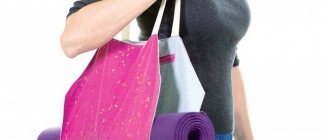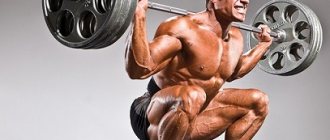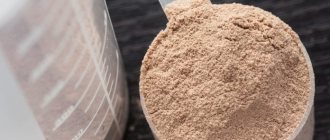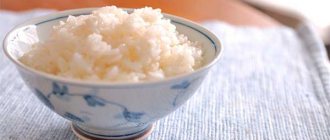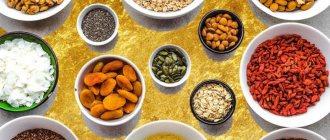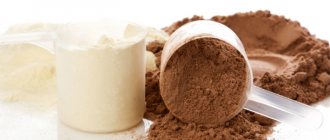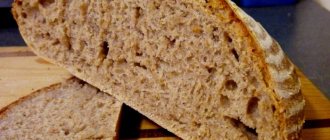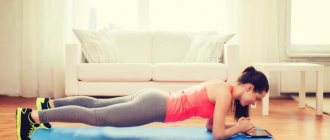PVC mats are lighter than rubber and are less subject to wear. The well-known European brand Manduka gives a lifetime guarantee on PVC mats.
Cheap PVC Mats – Yin Yang Studio
More expensive PVC mats - Manduka Pro Lite Mat
TPE mats
Lighter than PVC mats, they come in many colors and often have two working sides of different colors. Easy to clean. The downside is that if you keep the mat rolled up for a long time, then when unfolded, the ends of the mat will bend. The cost starts from 3,000.
Example:
Rubber mats.
Most professional and high-quality mats are made from rubber.
They adhere well to the floor, are quite durable, absorb moisture, and are slightly sensitive to surface unevenness.
The downsides are weight and price. Thin models (1.5 mm) made of full rubber cost from 4,000 rubles. Thicker (4-5 mm) from 6,000 rubles.
You can also see various rubber-based materials; they appeared on the market relatively recently. As a rule, they are lighter, but their price depends on other parameters, for example, a rug made of this material Ojas Salamander Comfort costs 6,000 - 7,000 rubles, and Manduka GRP 8,000 - 13,000.
Example of a rubber mat:
Rubber mats made in Russia – Rubber mats Devi Yoga
Rubber mats from the American brand JADE YOGA – Yoga mats Jade Yoga
Rubber mats from the European brand Manduka - Manduka eKO mat 5 mm
Do you need a yoga mat?
Is it possible to do yoga without a mat? Yes, you can make your own yoga mat using either a regular rug or fabric. Long before the advent of special mats, people practiced yoga either on grass or on a mat of animal skin. As the asanas became more complex, the need for better shock absorption arose. Cotton towels began to be used, which eventually evolved into synthetic fabric rugs.
The modern yoga mat didn't come into existence until the 1960s. Now he has become the best friend of every yoga practitioner. The importance of the mat in the life of a yogi is difficult to overestimate. In addition to providing protection from cold, hard floor surfaces, it helps prevent slipping by keeping your arms and legs in place while performing poses.
Yoga mat is:
- comfort - different thickness, length, anti-slip properties of yoga mats - everything for an ideal practice;
- hygiene - your personal mat can be cleaned as often as you need it (following the manufacturer's recommendations);
- aesthetics - the variety of modern yoga mats allows you to choose an option to your liking;
- incentive - a new mat can push you to start practicing;
- protection - will not allow the floor to absorb your energy/heat.
A yoga mat is your space, a calm place to relieve stress and energize your chakras
With the purchase of a yoga mat, your practice will reach a new level.
Description
Depending on the material used, thin or super thin yoga mats are durable and resistant to damage.
If you decide to buy a thick and comfortable mat, the “thickness” parameter should vary within 6 mm. This is a great choice for yogis who want to practice at home.
Medium models
The legendary black PRO Manduk mat has a 6 mm thickness and a lifetime guarantee.
The disadvantage of thick mats is the high price and the fact that they are heavy. If you will be shuttling between home and a yoga studio, the best solution would be a medium mat with a thickness of 4-5 mm. A good example of an affordable mat is the EKO Manduk (5 mm) or the Yin and Yang Studio mat (4.5 mm with the lowest price level). In the differences in the qualities of the rugs, it is difficult to find a sharp transition; both rugs are a good compromise between comfort, durability, weight, and price.
A thick mat is an ideal choice for people who train at home and love comfort.
A medium mat thickness is also a good choice for those who will use it at home or in the studio. Most of them are available in lengths up to 200 mm.
Murugan
Made from natural material, the Murugan rubber yoga mat has phenomenal anti-slip properties. Cotton fiber is used to reinforce the Murugan. It is thick enough to absorb moisture during intense sweating. For yoga, the rubber used to make mats comes from the Brazilian Hevea latex tree. The product does not deform or lose its shape depending on operating conditions.
Reebok
Thin mats include (RSYG-11024). Its anti-slip structure helps keep your arms and legs in place while performing various asanas and also prevents the mat from slipping. The Reebok can be stored on a special riser because it has special eyes that allow it to be hung.
Review of the best yoga mats
A good yoga mat admittedly won't be the cheapest option. Consider it a long-term investment, especially if you plan to take your classes seriously, because it will last you for many years.
Here are the 6 best yoga mats according to our experts:
- Manduka Pro Mat - if you need a super elastic mat. While this mat is not ideal for hot yoga, it is great for home practice. With a thickness of 6mm, the mat has excellent cushioning (important for sore joints and sensitive knees and elbows) and a grippy structure for stability. The mat does not absorb foreign odors and does not leave a rubber smell on your hands, as it is made of environmentally friendly biodegradable PVC. Does not contain toxins such as phthalate. Manduka has been at the top of the list of the best yoga mat brands for many years.
- Ego Yoga Sky Mandala - mat and towel in one product. For those who sweat a lot while doing hot yoga (such as Bikram or Hot Vinyasa). The top layer of the mat is an ultra-absorbent microfiber cover that is bonded to a rubber base. The more you sweat, the more grippy the mat becomes, allowing you to focus on long asana holds, flows and inversions without the fear of slipping and hurting yourself. Plus, the rug is very beautiful!
- Ako Yoga Yin-Yang Studio Rishikesh. Want to get the most bang for your buck? Yoga instructors recommend a Rishikesh mat made of high-strength PVC with a reinforced mesh inside. The yoga mat is wear-resistant, with good adhesive properties and an optimal thickness of 4.5 mm. Suitable for both home and studios. Doesn't curl or move even during intense practice. Available in different colors and sizes.
- Manduka EKO SuperLite Travel Mat is a portable mat. If you want to take your mat with you when you go on vacation, you'll want to invest in something lighter than a standard home/studio mat. This ultra-thin mat can be folded into A4 format and placed in your purse or suitcase. Eco-friendly, made of natural rubber. You can choose from standard colors and limited edition colors.
- RamaYoga Revolution PRO - 4mm mat offers impeccable grip, ample cushioning and is lightweight. The mat is made from natural rubber, obtained from rubber trees, which is a rapidly renewable resource. Produced at a factory in Spain exclusively for the RamaYoga brand. Complies with European environmental laws.
- Ako Yoga Gang is a high-quality PVC mat, an excellent option for beginners and those who need good shock absorption, because the thickness of the mat is 6 mm. Despite this, it is very light, only 1.5 kg, so it is convenient to carry it with you to the studio or for outdoor activities. Suitable for fitness and other sports. Wear-resistant, soft and beautiful. The color is not monochromatic, but with streaks - it looks original. Brand country Germany. Country of origin: China.
Criteria for choosing yoga and fitness mats
The basic requirements for fitness and yoga mats are approximately the same, with the exception of some features.
Thickness and weight
The thickness of the mat is chosen individually, everyone has their own sensitivity. If you need to relax, not experience pain when pushing, or protect yourself from a cold floor, a thicker option is suitable.
Indeed, this factor greatly influences practice. If the mat is too thin, it may not provide enough protection to joints and bones, especially in kneeling positions such as crampon. Conversely, if the mat is too thick, it can cause you to lose contact with the ground, making balance difficult. It’s hard to imagine how many muscles must come into play to maintain balance in a “tree” position on a very soft surface.
The thickness of the mat, however, also determines its weight and volume. So if you have to wear your mat to the gym many times or for long periods of time, it may be better to sacrifice a little comfort and choose a thinner mat.
What thickness is available in the market:
- From 1.5 to 3 mm
These are the thinnest, lightest mats, easy to fold, they can be spread on classic mats, which are provided in the gym and yoga centers.
- 3 to 4 mm
This thickness is the most common and provides a good weight-to-thickness ratio.
- 5 to 6 mm
Rugs of this thickness are recommended for those with sensitive joints or people who have suffered injuries.
- Over 6-8 mm
Thick mats can make balance positions difficult. But on the other hand, these mats are suitable for outdoor activities or uneven surfaces.
Material
Material is another important factor, especially if you are allergic to certain chemical components.
Here is a list of the main materials found on the market:
- TPE (expanded thermopolymer).
It has the qualities of elasticity, impermeability and wear resistance, with the addition of being completely odorless, hypoallergenic, easy to clean and completely biodegradable.
- PVC (polyvinyl chloride).
A widely used material, as it is quite inexpensive, has good strength and adhesiveness. But sometimes it is toxic and has a strong negative effect on the environment both at the production stage and during disposal.
- Natural rubber and recycled natural rubber.
This is a new trend in floor mats. They are completely recyclable, biodegradable and eco-friendly. They have excellent stickiness: they lie tightly on the ground without making “ears” or cuffs. Absorbs sweat well. However, natural rubber has a significant drawback: it should be avoided by those with latex allergies. It is also heavier than PVC or TPE.
- Organic cotton, jute, bamboo and cork.
These are all excellent natural materials. But they also have their drawbacks. First of all, all these new products are expensive. Cotton may not adhere well to the floor. The texture of jute can be irritating if you rest your face and body on it for a long time. As for cork and bamboo, they are not very widespread and not so easy to find.
High-quality products always come with a quality certificate, which contains a description of the composition. Unlike fitness mats, yoga mats are increasingly made from natural ingredients.
When doing fitness, there is increased sweating, so for these mats an important and urgent requirement for the material is antibacterial impregnation. It is also better to buy a product with reinforced lavsan threads. They do not allow the mat to lose its shape, are generally stronger and slip less than others.
Lenght and width
The standard length is about 180 cm and the standard width is about 60 cm.
When choosing, you need to add 10-15 centimeters to the body length. A larger size is always more comfortable. It would seem that the difference between 58 and 62 cm is small, but during training it is quite noticeable.
The advantage of a large rug is that it has a larger support surface, while the disadvantage is that it is too bulky to transport and does not fit into standard bags or doorways. In addition, in a crowded hall it can cause inconvenience to other students.
For those with short stature, 150 centimeters may be enough. Of course, you can’t do without supports under your head or feet in certain poses, but in general, this length can allow you to perform basic asanas. If you are tall, a short rug is a waste of money.
Price
Today, the carpet market offers products suitable for any wallet. You can find inexpensive mats starting from 400 rubles and environmental and super technical mats with exorbitant prices.
There are a lot of offers of inexpensive rugs on the market; prices are encouraging not only on AliExpress.
A rug that is too budget-friendly will have a short lifespan and, as is often the case, it is made using potentially toxic materials. And also very often they are slippery and do not stick well to the ground.
Expensive yoga mats are of superior quality and are typically used by those who spend a lot of time training and have different space and functionality requirements than casual practitioners.
It must be taken into account that the cost is ultimately depreciated over time. However, the longevity of a rug depends not only on the price, but also on how it is treated. Even the best mats may not last long if left in the sun or not cared for.
Yoga mat structure
- Closed cells.
The closed cell mat is ideal for those who practice more static yoga, such as the practice of Hatha or Yin yoga, meditation or pranayama. Closed cell mats have a smoother appearance, are more durable and absorb less sweat.
- Open cells.
They are ideal for those who practice intense yoga such as Ashtanga yoga, Vinyasa or Bikram. These mats tend to be very sticky, absorbent and soft to the touch. Because they absorb a lot of sweat like a sponge, they also absorb dirt and bacteria and need to be washed frequently. They generally have a shorter lifespan than those with closed cages.
For fitness mats, cell characteristics are not as important as for yoga.
Color and texture
The choice of color should not be underestimated, given that the mat will always be in front of your eyes during practice. You need to choose a color that you like, and it will fill you with a feeling of calm and satisfaction.
Many modern rugs, especially those made from natural rubber, have raised patterns that are used to help improve grip and reduce slipping of hands and feet.
Which one is better to buy? One that suits personal needs: pleasant to the eye and to the touch, especially in positions such as upside down dog.
Yoga mat Manduka Pro Mat 180x66x0.6 cm
12,100.00 ₽ More details
A good mood during yoga directly depends on a comfortable mat.
Buying the best yoga mat is an important decision. A new mat can make a real difference to your practice.
Level of training
How to choose the right yoga mat, given the practitioner's skill level? Beginners tend to have easier poses compared to those with intermediate skills. The higher the level, the more varied the asanas, and it is important that the yoga mat can provide comfort as the difficulty also increases.
Here are some recommendations for choosing a rug depending on who you are buying it for: a child, a beginner or a pro.
Mat for children
As yoga becomes more popular, parents are increasingly keen to get their children into the practice as early as possible. The first step in this direction is to buy a cute children's rug. What to look for when choosing the first mat for a little yogi?
Yoga develops concentration, balance, general mental and physical fitness of the child
Ideal children's rug:
- Safe: non-toxic, eco-friendly and easy to clean;
- lightweight - the mat should be easy to carry;
- non-slip – yoga mats are slightly sticky and should provide reliable grip for an active boy or girl;
- small - the length of the mat is 150 cm optimal for a child;
- beautiful - a cheerful print or favorite color will delight your baby.
Check out our selection of kids yoga mats
How to choose a yoga mat for beginners?
If you are at the beginning of your journey to increased flexibility and enlightenment of your body and mind, you are probably wondering: “Which yoga mat is best to buy?”
For beginners, when choosing the most important exercise accessory, there are several qualities to consider: thickness, moisture wicking, slip resistance, stability and price.
Thicker yoga mats are ideal if you have joint pain. They won't provide good balance, but will relieve pressure on your knees. If you don't want to buy an expensive first mat, there are beginner models that are extremely affordable—but they typically aren't durable or as functional as higher-quality ones.
Often it is the purchase of a mat that creates motivation for beginners to practice.
Whatever your ultimate goal in yoga, there is a mat that is right for you. Check out our range of beginner rugs.
Check out our selection of yoga mats for beginners
Professional models
For pros in the art of yoga, natural materials are important. Luckily, more companies are making sustainable, pollution-free yoga mats.
Eco-friendly yoga mats are available in a variety of varieties today. Each one is designed for a specific yoga practice. Materials: Rubber, organic cork, jute and cotton are used to make natural yoga mats.
Professional yoga mats are recyclable
Eco-friendly rugs are good for your body, mind, soul and the environment. We have collected the best natural mats that will meet the needs of pros in the art of yoga.
We invite you to consider a selection of yoga mats for professionals
Materials
Rugs, as we noted earlier, are made from different materials, usually natural and synthetic. Let's tell you a little more about each. For example, natural rugs contain the following elements:
- Rubber. A popular material, it is not durable, but does not create unpleasant static electricity.
- Jute. Natural fiber, quite elastic. Jute is produced from a plant of the Malvaceae family. The material is dense, durable, and contains no foreign impurities. Jute is often used in combination with synthetic components. A natural, comfortable coating is formed.
- Cotton. Absolutely natural raw materials, used in the production of reinforced mats. Cotton itself is lightweight, but when combined it creates a strong mat that is built to last. Even with regular training, such a mat will not lose its attractiveness.
Synthetic mats are as follows:
- PVC. Elastic and durable material, service life exceeds average. This is why mats are so popular among buyers, both beginners and experienced yogis.
- TPE. This is a new generation material, it is environmentally friendly and can decompose without much difficulty. The mats do not absorb sweat and dirt and are easy to wash if necessary. In addition, they are pleasant to the touch.
- Microfiber. The material is characterized by versatility. The weight of such a rug is light, it is resistant to external influences and does not fade over time.
Price for yoga mats
Generally, a simple, solid 3-4mm thick PVC yoga mat will be on the lower end of the price range. The price increases due to the product material, brand, individual design, antimicrobial and non-slip coating, complex textures and patterns.
Depending on the cost, yoga mats are:
- Budget - products from 600 rubles. The mat is good for beginners and those who have not yet decided what type of yoga and fitness they will practice. An inexpensive and simple mat is perfect for anyone who is afraid to pay the cost of more luxurious models.
- High-quality mats from RUB 1,890. for children and from 2330 rub. for adults. Durable, with good sticky properties, do not stretch or crumble. Suitable not only for intensive home practice, but also for studios with high traffic volumes.
- Premium - eco-friendly mats made of rubber, biodegradable premium PVC, jute or cork for those who are serious about yoga for a long time. Cost from 4200 rub. and higher.
We will tell you how to choose a yoga and fitness mat based on your budget
Eco-friendly yoga mats are at the top of the price range
What to make a rug from?
In addition to the quality of the material, you should pay attention to its color. In order not to be distracted during classes, it is better to choose not a colorful one, but a calm, monochromatic option.
By the way! Blue and light blue colors will help you relax, black will help you concentrate, purple will help you get creative, and green will help you achieve harmony.
The material for the product can be natural or synthetic. Natural materials are environmentally friendly and help you feel more subtly the connection with nature and the body.
Perfect for:
- Cotton
- Wool, sheepskin
- Rubber
- Bamboo fabric
A synthetic fiber gymnastics mat also has its advantages. Firstly, the product is light weight, and secondly, it is easy to maintain. Often, such a rug can be cleaned with a simple damp cloth.
Suitable materials:
- PVC
- Thermoplastic
Getting to know the brands
If you are one step away from choosing the right yoga mat and have already studied both the characteristics and customer reviews, you will be interested in learning a little about its manufacturer. Here are some details about the brands in our store:
- Ako Yoga is a German brand that has been producing PVC-based yoga mats since 1960. The main mission of the company is product safety. Since 2006, the products have been awarded the OEKO TEC Class 1 title. This means that the materials used are absolutely harmless and can even be used by children! Products are regularly tested by an independent laboratory.
- Ego Yoga is perhaps one of the most eco-friendly brands of yoga products. Its assortment includes original mats made of microfiber, cork and rubber. The line of premium mats with a non-slip coating deserves special attention; such products do not slip with either dry or wet palms. The company also produces nice covers, and more recently sadhu boards have appeared in their range. And all this is produced here - in Russia!
- Manduka is a leader in the yoga industry in providing mats, stylish apparel and a wide selection of yoga accessories. By investing in rugs from this company, you can be sure that you will get the most out of the quality of the product. The products are environmentally friendly and biodegradable. Country of origin: USA.
- RamaYoga is a Russian brand that offers yoga products in an affordable price range for most buyers. RamaYoga Puna is the best budget mat from this manufacturer. Perfect for beginners and anyone who is not considering expensive options. You will be pleasantly surprised by the quality and range of colors. The mat is made of PVC and has an ideal thickness of 3-3.5 mm.
- Starfit is a budget brand. Country of origin: China. It is also latex-free for allergy sufferers, although some have noted that it may initially have a PVC odor, so the manufacturer suggests airing out the mat before first use.
- Wunderlich is a German brand of quality carpets. It is very popular in Russia because it is in the middle price range. The products comply with European environmental standards.
- Yoga Club is a famous Russian brand of designer mats and accessories. Rugs from this company are for those who love natural materials and beautiful appearance. The creators of the brand are experienced practitioners and know exactly what is important for a real yogi.
Price
Rugs are cheaper than 1000 rubles. It's better not to consider it. Budget models cost about 1500 - 3500 rubles. Basically, these are PVC or TPE mats made in China. Rubber mats start from 4,000 rubles. (thin models can be found a little cheaper), their price is further influenced by thickness and size, as well as coating and manufacturer. A good rubber mat from an American brand costs about 7,000 rubles. You can also buy a high-quality reinforced PVC mat for this money. Prices for thick and wide reinforced mats of Western production from a famous brand reach 15,000 - 20,000 rubles.
Budget
Mid price category
Expensive
Yoga mat sizes: different lengths for different heights
How to choose the length of a yoga mat? The size of an average yoga mat is 175-185 cm in length. The length of the mat is calculated based on your height. It is customary to add 5-10 cm to your height to determine the optimal length of the mat. The taller you are, the longer the mat you will need. It is also worth paying attention to the type of practice: for classes with stretching and throwing, you can safely add even 20 cm to your height; for classical yoga, plus 5-10 cm will be enough.
By length, rugs are divided into:
- Short - 150 cm option for children,
- Medium - 173 cm, 175 cm, 183 cm and 185 cm are suitable for most practitioners.
- Extended - 200 cm, 220 cm for tall yogis and those who simply want a longer mat.
Comfortable length of the mat - when the head and legs lie on the mat when performing Shavasana
Longer yoga mats are a little heavier to carry and bulkier when rolled up, but this is a minor drawback when compared to comfort during practice.
Deciding on the sizes
How to choose a comfortable mat for fitness and yoga? It is important to determine the optimal size of the rug, which will depend on your parameters. Some useful tips:
- The length of the rug can vary from 170 to 240 centimeters. How to decide? It all depends on your height, as well as the exercises you plan to do. So, if the classes are calm and not too dynamic, then to determine the optimal length you should add 10 centimeters to your height. If your workouts are dynamic, then add 20-40 centimeters to your height; it will be uncomfortable for you to exercise on a mat that is too short.
- The width usually varies from 60 to 80 centimeters. Of course, it is best to choose a wide mat so that nothing hampers your movements. But if you have to take public transport to the gym, then such an accessory may interfere with you and other passengers. But remember that rugs that are too narrow are not very comfortable.
- Now you need to decide on the thickness. In general, it can vary from 1.5 to 6-8 millimeters. It is better to choose a fairly thick rug. Firstly, it will protect you from the cold coming from the floor, and, secondly, it will provide maximum comfort during exercise and will help you lean on your knees or elbows without discomfort. So the optimal thickness is 4.5-6 millimeters. There are also thicker mats, but you should not purchase such an accessory, it can prevent you from feeling your own body.
When rug width matters
The standard mat width is 60 cm - suitable for most practitioners. In addition to the classic width, you can also find yoga mats in widths of , , , 100 or 120 cm.
Wide models are for those who want a little more room to maneuver or have a larger build. In addition, they are good if you need additional space to perform such asanas when your arms and legs tend to move off the mat. This is also a suitable option if you want to increase the distance between you and the person next to you in the yoga studio.
It's important to consider the increased width when choosing a bag or mat cover. If you buy a cover for a standard width, the mat will stick out or won't fit at all.
A tie strap is a convenient option for carrying a mat of any width.
If you are taking a yoga class and the teacher says, “Put your feet the width of the mat,” your feet should be slightly narrower when your mat is wider than standard
How to use a fitness mat during training?
A very convenient folding fitness mat. After all, after classes you can easily fold it and hide it. To start using this accessory, just unfold it and you can start doing exercises. After training, you should roll the mat properly. In addition, do not forget that after some time this accessory may become dirty. Therefore, you should also take care of it. In order for it to serve for a long time, you need to adhere to these simple rules:
- Once the product has been purchased, it also needs to be washed. If it is made of PVC, it can be machine washed. Accessories made from other materials must be washed by hand. Soap and water will often do the trick. When it gets dirty, it should also be cleaned.
- Do not fold the rug, as this may cause creases. It is recommended to twist it. This way it will retain its shape and last longer.
- Do not use aggressive detergents for cleaning, as they can cause damage to the material.
- It is recommended to choose the right attribute for yoga or fitness. It should be comfortable to work on.
How to choose a good yoga mat thickness?
Yoga mats can be from 1 mm to 6 mm thick. To figure out how thick a yoga mat should be, it is important to consider your body weight and the style of yoga used for the practice.
What thickness of yoga mat is best? Why is it important? How comfortable your yoga mat will be depends largely on its thickness. Too thin and your knee may hit during Half Moon Lunge (Anjaneyasana). However, thick yoga mats can make it difficult to perform balance poses, as they will make you less stable, for example, in tree pose (Vrksasana).
A standard yoga mat is about 3.5-4.5 mm thick, and the thickest is about 6 cm. A yoga mat with an optimal thickness is great for any style of yoga. Thicker mats are suitable not so much for yoga as for fitness (from 8 mm or more).
There are also thin options, often called “travel”, with a thickness of only 1-1.5 mm. They fold easily and weigh little, making them easy to fit in a suitcase.
The thickness of the yoga mat contributes to body comfort during classes
If you practice yoga with knee or wrist pain, it's worth investing in a thicker mat that will give your joints some protection
TOP 10 yoga mats: comparison table
| Size(mm) | Material | Color options | Bag | Price, rub.) | ||
| 1 | The cheapest with fast delivery! | 1830*610*6 | PVC | 4 colors | No | 500 |
| 2 | 1730*610*4 | EVA | 6 colors | No | 650 | |
| 3 | Optimal in terms of price/quality! | 1830*610*6 | TPE | 1 color | Carrying strap | 1070 |
| 4 | 1830*610*6 | TPE | 2 colors | No | 1300 | |
| 5 | 1830*660*6 | TPE | 10 drawings | No | 3900 | |
| 5.1 | 1830*800*6 | TPE | 10 drawings | Yes | 4300 | |
| 6 | With markings for adjusting asanas! | 1830*800*6 | TPE | 6 colors | Yes | 1600 |
| 7 | 1850x800x10 | NBR | 3 colors | No | 2200 | |
| 8 | 1830*680*1,5 | Suede/TPE | 7 drawings | Yes | 2700 | |
| 8.1 | 1830*680*1,5 | Suede/TPE | 6 drawings | Yes | 2200 | |
| 8.2 | 1850*680*1,5 | Suede/TPE | 5 drawings | No | 2200 | |
| 9 | The cheapest of the beautiful! | 1830*610*5 | Suede/TPE | 5 drawings | No | 1700 |
| 10 | 1830*610*6 | Cork/TPE | 12 drawings | No | 3200 |
Pay special attention to options: 1 - the cheapest and with fast delivery; 3 and 4 - excellent value for money; 6 - with markings for correct adjustment of asanas; 9 is the most affordable of the rugs with original colors.
And feel free to take rugs 8-8.2 with a thickness of 1.5 mm on a trip!
Choose your option right now and practice yoga with comfort and pleasure!
What is the best yoga mat material?
Why is the material from which a yoga mat is made important? It's simple: it determines its texture, stickiness, environmental friendliness, shock absorption and how it wears over time.
Let's take a closer look at what material to choose a yoga mat from, and how they differ:
- PVC (polyvinyl chloride) - Most standard yoga mats are made from this material. If you want a tried and true sticky mat, choose a PVC mat that can withstand use for over a decade.
- Jute - If you support eco-friendly products, then this is an ideal choice. Jute mats have an organic roughness and provide good grip. However, they also have their drawbacks. Jute mats are made from porous plants and for this reason have the ability to absorb sweat. Over time, this will weaken the structure of the rug.
- Rubber is the choice of many yogis and environmentalists. This is also a cost-effective purchase - rubber models are very durable. They provide excellent grip no matter how vigorous your practice. However, avoid them if you are allergic to latex.
- TPE (thermoplastic elastomer) - TPE mats are suitable for fitness and yoga and are softer, lighter and more flexible than PVC mats. More pleasant to the touch, keep their shape well. They do not fade in the sun and are resistant to frost. They don't slip, making them suitable for yoga.
- Cork – Eco-friendly yoga mats are made from natural cork and are free of harmful chemicals. Biodegradable and recyclable. The surface of the cork is naturally antimicrobial, making it suitable for allergy sufferers.
- Cotton is a natural material that is easy to care for and portable, and can be used over a studio mat for better moisture absorption during practice. Looks authentic!
- Microfiber - used in two-layer rubber-based mats. Suitable for hot yoga due to its good absorbent properties. Microfiber rugs most often have beautiful designer patterns; you can choose one that will reflect your inner world.
The non-slip surface of the cork yoga mat will provide traction during strength and hot yoga.
The above options are not all materials for making rugs; each of them has its pros and cons. Our specialists will help you decide!
What are rugs made of?
Modern rugs come in both artificial and natural materials.
The most important thing in the material is that the mat does not slip, especially if your hands and feet sweat.
Another important characteristic is strength. It's good when the rug lasts a long time.
The cheapest material - from which travel mats are sometimes made - is EVA. EVA mats are cheap and lightweight, but are not very durable and may smell bad when purchased.
The next option is PVC. This material is more wear-resistant and less slippery, and is also quite cheap. Most fitness mats sold in supermarkets and sporting goods stores are made from it.
But the most suitable modern material is TPE. It is more environmentally friendly, its anti-slip properties are not inferior to natural rubber, and it is very lightweight. Rugs made from it are somewhat less durable than those made from PVC - they should be protected from cat claws and improper storage - but much more comfortable in terms of exercise.
Natural materials used are rubber, latex and cork. Rugs made of natural rubber and latex are expensive and heavy, but cork is a very nice material that is worth taking a closer look at. Typically, such a mat is made of modern non-slip material on one side, and cork on the other side - where you will practice.
Finally, recently double-sided mats have come into fashion - on one side it is TPE, and on the side you will be working on, it is cotton or suede. Such rugs come in thicknesses of 4-5 mm, or very thin, for travel and trips. These rugs cost a little more, but their advantage is that they come in absolutely any color. And this is also an important point.
Can the color of your yoga mat affect your practice?
If color psychology is close to you, then this information is for you:
- Red - attracts attention, stimulates, increases heart rate and increases blood circulation. In other words, it is a charge of energy.
- Orange – Sultry orange can bring a little levity to your practice.
- Yellow – Shiny, cheerful yellow can be the right yoga mat for those days when you feel sad.
- Green – Often used to represent balance and harmony, it provides complete relaxation.
- Blue – With the ability to calm the mind and aid in concentration, a blue yoga mat can help you accurately perform each pose to the best of your ability.
- Purple – Helps raise awareness to a higher level.
- Pink - If you are looking for healing energy and rejuvenation.
- White - if you want a good dose of emotional and mental cleansing.
- Black is the right color choice that will bring a relaxing component to your yoga practice, creating a calm and powerful relaxation without distracting attention from the mat itself.
Interestingly, many yogis choose blue as their preferred color.
Choosing the color of your yoga mat depends on what you like and what you want to achieve in your practice.
Color cannot be the only selection criterion. But it is definitely one of the main reference points for many, so we recommend using the filter by product color on our website
Tips for choosing
The selection criteria below will help you purchase a high-quality and effective product.
- Environmentally friendly. A true yogi strives not only for internal purity, but also for the purity of the surrounding world. Based on this factor, try to find money for a rug made from natural materials that does not harm you during use and quickly decomposes during the period of decay.
- Width. Please note that the usual width of the rug is equal to sixty centimeters. Such bedding is suitable for most fans of Indian culture. And for those who own a larger package, product options are available; their width is equal to eighty centimeters.
- Skin grip. It is important for yoga practitioners not to slip on sweaty palms and feet, because the correctness, and therefore the effectiveness, of performing the asana directly depends on this factor. The following natural materials provide a good level of adhesion: silicone, jute, etc.
- Design. Choosing a rug based only on the color and pattern on it is obviously the wrong decision. But when you have decided on all the other parameters, be sure to choose the design that you like best. Just one glance at the product should put you in a state of “combat readiness”. After all, if you really like something, it becomes an additional source of energy and endorphins.
Features of choice: what to look for?
There are many yoga mats out there, and there is no one-size-fits-all choice, so consider the following tips before purchasing your best mat based on its features:
- Large - A mat for tall yogis or those who need extra space during their practice.
- Two-layer - a two-in-one product - absorbent microfiber instead of a towel and a rubber base. Ideal for hot yoga and those who sweat intensely during practice.
- Designer - beautiful, stylish and unique, for those who care about the visual effect.
- Hard – Hard mats are typically made of rubber. They are heavy but provide great stability for advanced yogis in challenging poses.
- Compact - for easy carrying and long trips.
- Lightweight – The lighter the yoga mat, the more comfortable it is to carry or take with you when traveling or visiting a yoga studio.
- Soft – Often made from PVC, it is lighter, less expensive and has more cushioning for beginners or those planning to use the mat for other workouts, such as fitness.
- Natural (ECO) - corresponds to the basic principle of yoga - to be closer to nature.
- Non-slip - mats with a non-slip coating will provide the maximum possible grip during practice for both dry and wet palms and feet.
- With markings - for fine-tuning asanas - ideal for beginners.
- With a pattern - if you want to stand out among others in the yoga studio, choose a mat with a picture that you like.
- Thick - Provides better support and shock absorption for joints, knees, heels, head and other parts of the body. Reduce pain in legs and ankles when sitting for long periods of time. However, they are bulky and can make balance poses difficult.
- Thin - Preferred for poses that require balancing. Lightweight, compact. But not suitable for people with joint problems.
- Travel - travel mats can be as thin as 1 mm. It can be easily folded into a square and placed in a regular suitcase or handbag. This mat can be used over a studio mat to ensure hygiene.
- Wide - ideal when performing shavasana; your hands will not touch the cold floor.
A yoga mat should be able to assist in performing difficult exercises
Whatever style of yoga you learn, it's important to be comfortable to reap the full benefits of the practice.
If you still have questions about how to buy a good quality yoga mat, write to our managers or call +7 (495) 128-6112, experienced yogis and yoginis will be happy to select the option that will ensure a fruitful practice!
Types of rugs
It is best to look for a special mat specifically for the type of activity you are going to do; Many properties of the mat will depend on this. For indoor exercises, the mat can be thinner, but outdoor exercises require a thicker coating - from 8 mm: this way they will protect you from moisture and cold from the ground, and will also smooth out the unevenness of the natural terrain. For active fitness, which provokes heavy sweating, you need non-slip mats (for example, made of rubber) so that even wet hands do not move on its surface; if the training is not so energy-intensive, you can pay attention to other criteria.
By the way, there are also separate mats for different types of fitness training. For example, an abs mat is a special pad for abdominal exercises that looks like a small pad for the lower back. You can also find transformable flex mats, which are cut into several sections on one side. This allows you to fold them several times and get the most convenient covering option for a particular exercise.
ezflexmats.com
A common mistake is to buy travel foams made from EVA material (ethylene vinyl acetate). Their main advantages are softness and thermal insulation: when hiking, they are placed on the ground or on stones so as not to sit on cold and hard things. These foam mats do not have other properties that are needed during fitness classes. They get wet easily and also slide on the floor.
